What’s in My Camera Bag (2024)
Bruno Fujii
9 min read
Intro
This topic is definitely on going trend on the internet, from blog posts like this to a plethora of YouTube videos and Instagram Reels. You can spend a pretty good time seeing what’s in other professional or hobbyist photographers’ camera bags — I’m guilty of that. Of course, this can often make us wonder if we should upgrade some of our equipment, which is not my purpose. For this reason alone I’ll share a little bit of how I got to this point.
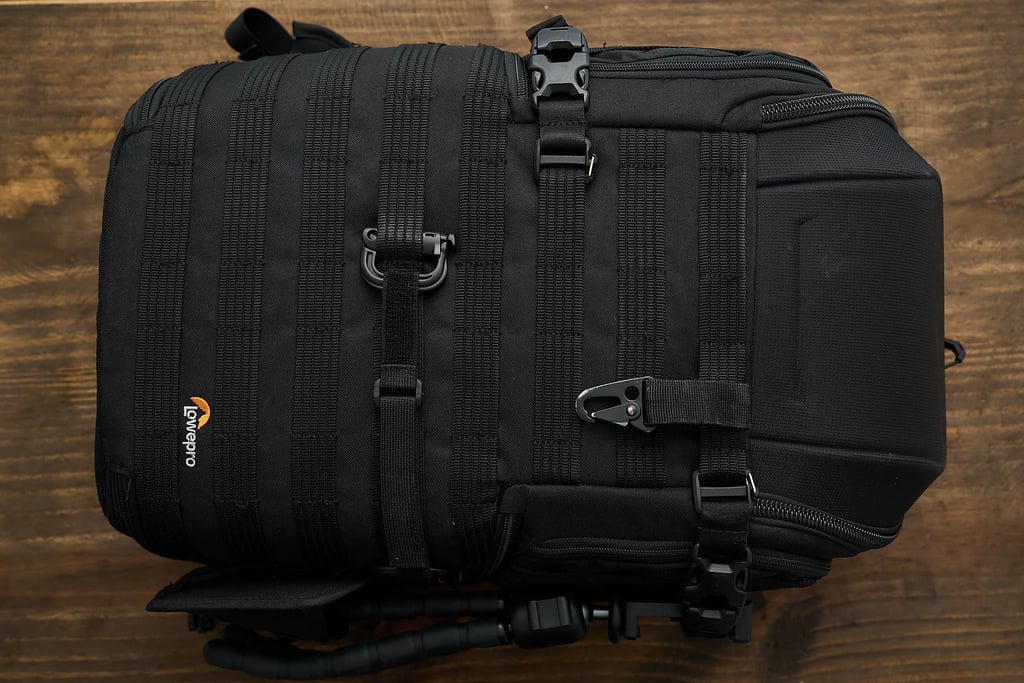

Backpack
Nowadays there are plenty of brands with good quality and designs products (bags, messengers, cases and accessories), but Lowepro was always that brand I could trust when carrying my equipment. A Pelican hard case with foam padded inside is indestructible and will protect the gear better, but it is just not practical as ready-to-go alternative.
Back in 2015 I traveled to Minas Gerais for my personal project “Minas Gerais: In the Backlands Paths” with a Lowepro Pro Roller x100 airline-compatible roller bag. The x100 can be converted to a backpack, which is very handy, but not much comfortable for a longer walk. In my never ending search for more mobility, I changed to the first version of the Lowepro Fastpack 350. I had to use it alongside with a Lowepro Adventura 170 shoulder bag for my lightning kit — at that time I was using a Paul C. Buff Einstein E640 and a Vagabond mini battery pack — it’s not a big kit at all, but with chargers, extra battery and cables, it adds up (more on that later).
Currently I’m using the Lowepro ProTactic 450 AW II. Although I really like the quality of Lowepro products, honestly I wasn’t very excited about their designs. It all changed when they released the ProTactic series. It had everything Lowepro known for, but with a modern streamline design. The 450 version is big, and gets heavy when all packed. Even with a padded back, I wouldn’t recommend packing the 450 version with a lot of gear for a hiking or a traveling tour. I use it only for transportation, and it works perfectly for me.
I bought the ProTactic a few years ago right after it was released and it is still going strong. I don’t think I’ll switch for anything else in the future unless I change my needs. It’s perfect for me.

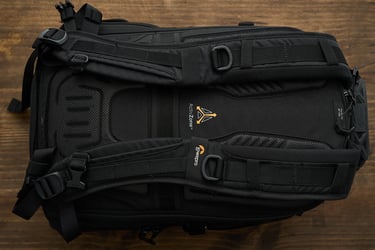
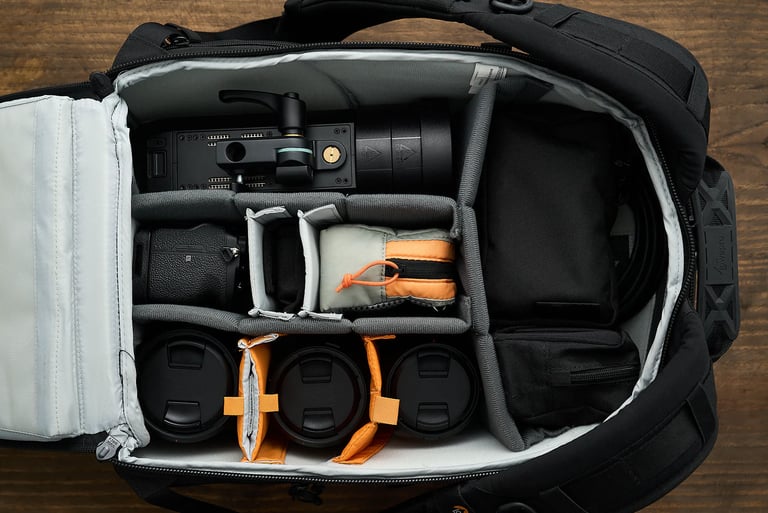

Camera
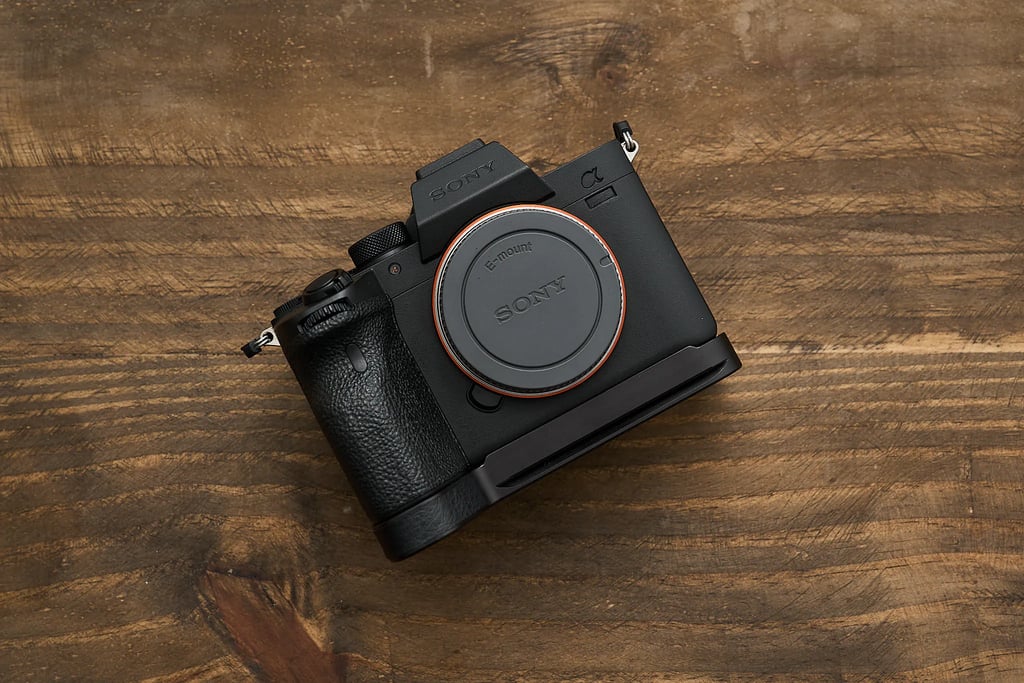

Yes, we all like camera and lenses. I do. But I do like photography more. I say this because it may seem obvious, but we can easily get carried away by G.A.S. (“Gear Acquisition Syndrome“). The term was created for describing the “compulsive accumulation of technical equipment” of Musicians with the belief of needing more gear to be a better player. It quickly became related to Photographers too.
I started like almost everyone interested in photography would start 10 years ago: with an entry level cropped sensor DSLR and a kit lens. My first camera was the Nikon D3100. Before I knew I bought the D7100 and right after that, the full frame D600. At that point I was really serious about photography and decided to get the D800. Just in a couple of months I went from an entry level to a “pro” level camera. The difference was huge. The Nikon D800 was a game changer with a whopping 36.3 megapixels when released in 2012. If you think about, 36mp is actually plenty enough even in 2024. Sony just released the a9 II with 24mp.
After some time with my D800, I unnecessarily upgraded to the D810. At that point, all new coming releases gets you to the “Law of Dimishing Returns“. Definitely better, but a marginal gain at a higher cost — not the best decision if you are a working professional and look for a sustainable business. After a few years Nikon released the D850, but I decided sticking to my D810 since it was getting the job done.
I truly believe the Nikon D810 is a very capable camera even after ten years of its release, but it was about time to make a move to mirrorless. Mirrorless was on the rise and not a novelty anymore, the system was improving drastically in a very short time. It was a serious new technology with good advantages over the DSLR cameras. But Nikon and Canon were a little late into the game… When Nikon released the Z mount system, Sony was already very established. I went with the Sony A7R III and it was a smart move for me: slightly more resolution at 42.4mp and impressive eye tracking capabilities. I miss the optical viewfinder, top display and ergonomics. But it is what it is and I got used to it.
Currently I’m using the Sony A7R IV as my main camera. I decided to upgrade it after landing a few good jobs. 61 megapixels it’s a lot for many, but for me is a good number. File sizes gets bigger fast when editing, and is more demanding on the computer, but it is perfect for commercial shoots. The newer A7R V has some new features including options for smaller Raw files, revamped menu system (finally!) and (more) advanced subject recognition AF, improved image stabilization. Some nice upgrades, but the A7R IV is still a very capable camera for me and I think it will be for a few years down the line. Maybe we reached a point where almost every camera is good enough for getting the job done with no compromises. The market will release new products with improvements, but not drastically differences.
P.S.: I’ll write another post with more details about my experience with Sony mirrorless system. I think it would be interesting sharing my thoughts on that.
Lenses

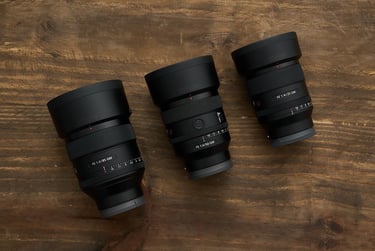
Date the body, marry the lens.
A common old saying among photographers. Either you like or not, it holds some truth even for today. Lenses will outlive the body most of the time. They will still be usable even if they don’t auto focus or don’t have good sharpness edge to edge. Actually these so called vintage lenses have gained value because of its characteristics. Some of them may seem like a gimmicky, such as the famous Helios 44-2, but it is indeed amazing that a lens with more than 50 years old is sought after by lot of photographers.
But setting up to a lens can take a long time and a lot of effort. There is not shortcut here: experimenting with different focal lengths will help making that hard decision. Some will stick to a couple of zooms, others will choose primes. There is no right or wrong, it all should depend on the style, preference and needs of each photographer.
My first lens was a kit lens, and obviously the nifty fifty next. During a period I used the 24-70 2.8 with the 50 1.8, until I changed to the prime kit: 35mm 1.8, 50mm 1.8 and 85mm 1.8. For a brief period of time I tried the zoom with a prime combo again because of the versatility. The G line of Nikon F-mount lenses were really amazing for the price, and it is what I needed at that time.
When I switched to the Sony mirrorless system I was surprise by the price difference of the budget lenses offering, they were so much more expensive. But the image quality was actually on another level. I went for a similar prime kit, but this time on the Sony system: 35mm 1.8, 55mm 1.8 and 85mm 1.8. I known nowadays third-party lenses can be as good as brand-manufactured lenses (or surpass like the Sigma Art), but I always went for the native options.
I’ve never been a “pixel peeper” of any sort, although I strive to deliver the best result for my clients and on my personal projects. And as contradictory as it may seem, I upgraded my Sony kit to the overkill G-Master Series equivalent. They are top-of-the-line optical performance with amazing built quality and auto focus. And the truth is that I didn’t actually neededit. They won’t make my work any better to be honest, but after 10 years in photography is a nice to have and I plan to keep them as long as I can.
Currently I have the 35mm 1.4 GM, 50mm 1.4 GM and 85mm 1.4 GM. I don’t even use them wide open on 1.4 too often; I like shooting at ƒ/2 or ƒ/2.8. Paired with the A7R IV, these new lenses are able to produce outstanding results with “medium format level”. Of course the look will be slightly different due the sensor size, but quality wise it is phenomenal.
Lightning


OK, everyone knows that the word “photography” means “drawing with light” (phōtós/graphê2). But sometimes the available light is just not good enough, that’s the reason for my style I aways carry with a me a lightning kit. In the beginning my approach to this was more artificial, but recently I’ve been using light just to enhance an environmental scene, for example. I love having the option to light a scene as I see fit. Even though modern camera sensors are able to shoot at extremely high ISO, the light direction and quality is paramount for a compelling image. Again: for my style.
My first serious kit was the Einstein Paul C. Buff, Vagabond Mini battery and a 47” Octabox. For a while I shoot everything with it. It was only when Godox released the AD400 Pro and AD600 Pro I was comfortable making the switch. Having a battery powered flash unit made my work so mush easier that I think I can never go back. It is not an overstatement to consider a game change for the industry. There are other brands with similar offers, but Godox made a good quality product more accessible for photographers.
Currently my basic lighting kit is just a heavy duty tripod, the Godox AD400 Pro, Godox X3 trigger, Godox UB-130 umbrella with diffuser. I do carry with me an extra battery, but that’s almost all I need for 90% of my work.
Other essentials

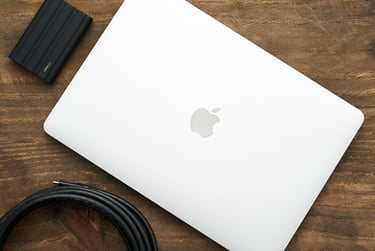
There are a few essentials I aways carry in my bag. The Macbook Air M1 is the first generation of computer with the revolutionary Apple chip. I’ve been working with Apple for more than a decade and there is nothing like it. More than enough for tethering my work with the Tether Tools cable with Capture One: compact, fast and reliable. A must have for anyone in the creative field. For backing up with redundancy I use two Samsung T7 SSD, and the Carbon Copy Cloner Software for creating an redundancy copy. A cleaning kit has been more important than ever now that I use mirrorless; the sensor is more prone to get dust and dirty, but it is also very easy to clean with a proper fluid and swab. And at last a notebook and pen is always good to have around. I know that we all have smartphones at our fingertips, but sometimes the old ways of taking is just more convenient.
Conclusion
To me this is an amazing kit to carry on my bag. I’m settled for now with what I’ve got, it took me years to get to what’s listed in this post. Trust me: there is no such thing as bad gear — some are more capable in some aspects than others, it’s true. Sometimes we may feel dissatisfied with our current kit and think a better camera or lens will make our work better. This is hardly the case, don’t let it hold you back. In the end, it shouldn’t be about the gear.
TL;DR
Lowepro ProTactic 450 AW II
Lowepro ProTactic 100 AW
Sony A7R IV
Sony 35mm 1.4 GM
Sony 50mm 1.4 GM
Sony 85mm 1.4 GM
Godox AD400 Pro
Godox X3
Macbook Air M1
Samsung T7 Shield SSD (x2)
Tether Cable/Block
Spare batteries for camera and light
Chargers and cables
Cleaning kit
Notebook and pen
References:
Shopping addiction. Wikipedia
Young, Rebecca. The birth of photography
Share this on:
